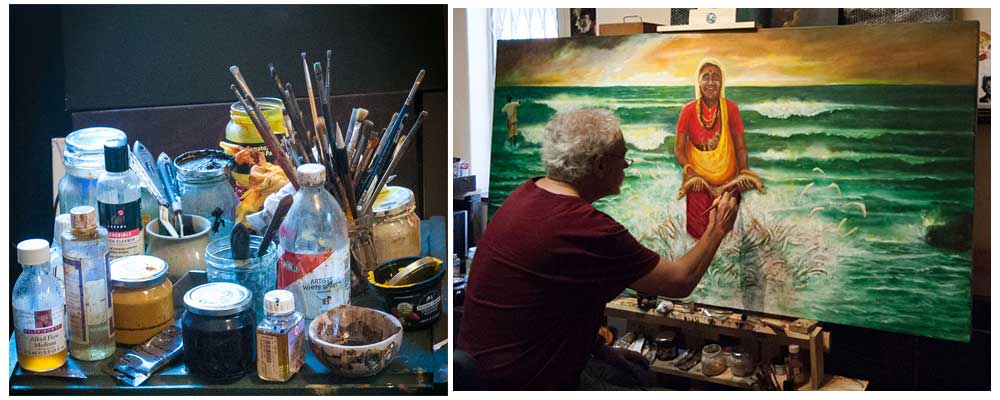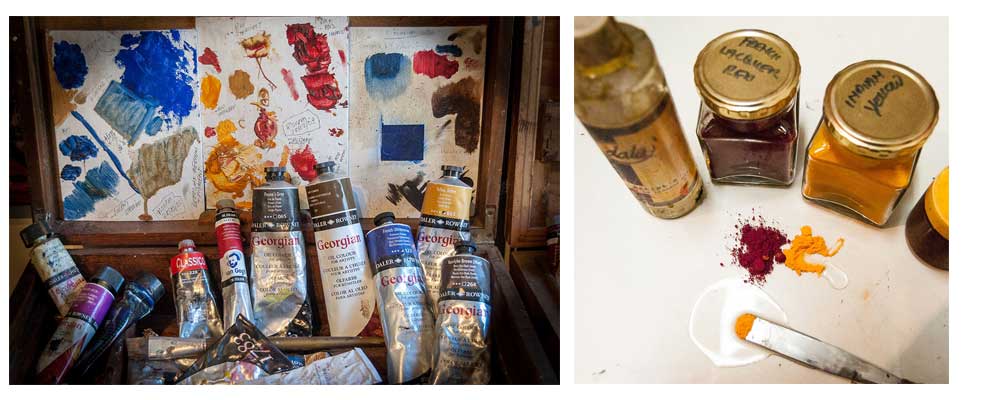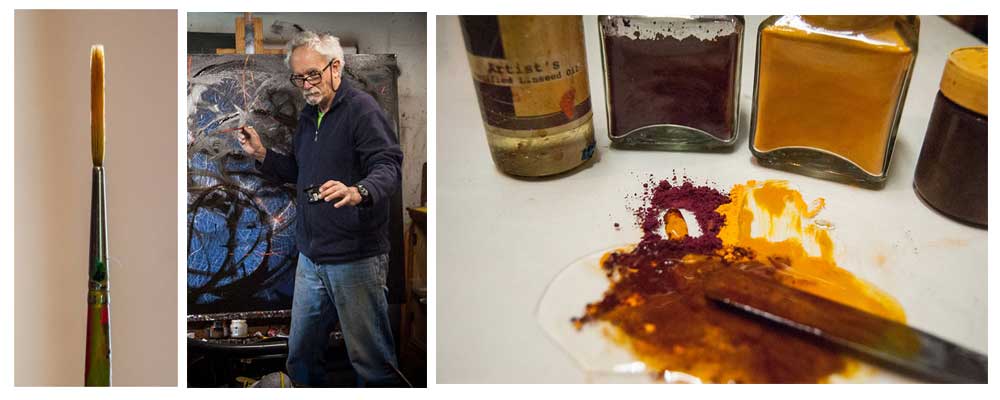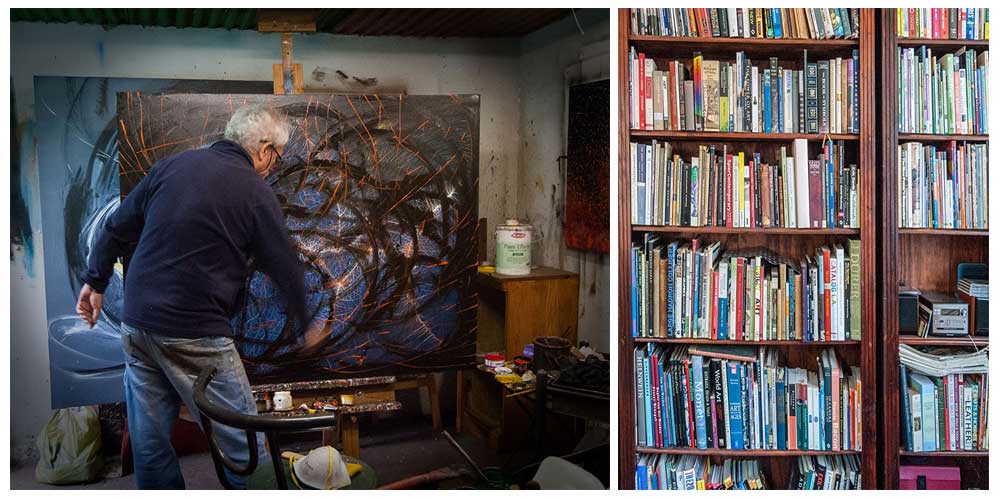StateoftheART is excited to present to you an all new Studio Feature for 2018! James de Villiers gives us exclusive insights into his studio space, history and art making process.

Favourite material to work with?
Oil paint. I make my own for smaller work and where I require special colours. I also use commercially available paints for my larger paintings especially the impasto abstracts. I often enhance the commercial paint with extra pure pigment.
What themes do you pursue?
Decay, energy flows, movement, change, the layering of history on the landscape, still life, skies (The Architecture of Air)
How many years an artist?
I've had an interest in art since my early teenage years when I was inspired by my mother to start painting, but I only started seriously painting from the age of 23. This means I have been active as an artist for forty years. This has not been a continuous activity however. From the early 1980's it became more consistent until the last five years or so when art making has become a full-time occupation.
What should people know about your art that they can’t tell from looking at it?
There is a large amount of research and observation that has gone into my work. Over the years I have looked for the most efficient and interesting ways of expressing myself. A large part of my work is directly influenced by my interest in archaeology, science and music.
Which living or dead artist would you most like to meet?
A difficult question as I admire so many, but William Blake would be at the top of the list. From school-days he has had a profound influence on the way I look at the world and influenced some of my behaviour and the way I approach painting.

Tell us about your studio. Location, clean, cluttered, big, small, etc?
My studios are at my home. I say studios because there is not one room alone that is adequate for my artistic practice. The large works I do in the single garage, this is where I can make a mess without worrying. My smaller paintings I paint in the former lounge area which I've always occupied. This doubles as the area where I also photograph the smaller paintings, drawings and prints, it also functions as my music and computer room. My other interest is music which comprises recording, composing soundscapes, playing experimental music with friends, remixing and mastering for other experimental, avantgarde musicians and the like. It ends up being my multimedia studio.
Two years ago I rented a large studio in the Newtown area of Joburg, but it was logistically wrong for me and seeing I had spent a great deal of money on acquiring a home, I decided to move back to utilising what I already had. I use the basement which is divided off for screenprinting in one section and general workshop activities in the other
Art school or self-taught?
Both. I never took art at school as it was frowned upon. I learned from the Walter T. Foster art books my mother bought as well as an American artist, Alois Fabry. The Walter T. Foster books introduced me to Hundertwasser and other abstract painters and the basics of painting although some of it was pure kitsch. I learned a lot from observing Rembrandt, I bought a book about him for my mother's birthday present one year, but I kept reading it and he instantly became one of my first painting heroes and I copied his work. I still have that book today. When I was 22 or so I received part time lessons from Susan Pontin. She had a studio in the centre of Pietermaritzburg. I would often see her walking up the road in her paint splattered clothes, smoking a cigarette and exuding the bohemian artistic lifestyle as she went to buy art materials and at that point I found her persona to be quite inspiring. She taught me about hard work and application. Susan was inspired by classical music and would interpret various pieces in her paintings. She drank gallons of tea and smoked innumerable cigarettes, working like a trojan. I never liked her own paintings though, but was inspired by her studio practice. She also taught me techniques of figure drawing. I was working in a terribly boring job at the time and her studio was a haven after work.
I knew quite a few other local artists and learned from them as well. This was the early 70's and I was deeply immersed in the hippy/avant garde scene of the time. Pietermaritzburg is a university city, so I had contact with many creative and inspirational people.
After that it was a time at the Creative Arts Studio run by an artist called Pam, (I have forgotten her surname), who was a graduate of the Slade School of Art in London. She ran this small art school in the centre of town upstairs in one of the old buildings where I met many interesting people. I was in and out of the studio all the time. They had a small coffee bar and art material shop attached. It was an unpleasant and vastly chaotic time of my life, but here I discovered a deep surrealist streak in my artistic make-up.
I left Pietermaritzburg, ending up in Bloemfontein where I attended the local Technikon and studied art for two years. I enrolled with Unisa for a Fine art degree and finished the whole course barring one history of art module which I have no intention of completing. I met inspirational lecturers there like Keith Dietrich, Ivor Powell and John Clarke. I still study art and art history on a continual basis.
Do you prefer to work with music or in silence?
It depends. When I do large abstract works I prefer energetic music, when it comes to intricate realist smaller scale paintings, something more meditative like Sibelius, Aarvo Part and quite often Beethoven. The reverse is fine as well. I also enjoy painting in silence.

Favourite brush?
A #3 rigger brush. Capable of holding enough paint to paint the finest of long lines. I can paint the largest of my abstracts with this one brush if necessary.
Where can we find you out side of the studio?
Going on long walks and in book shops.
If you couldn't be an artist, what would you do?
Photography, play music, do graphic design, quite a few things as I have a wide range of interests.
Interests other than art?
Music, science, media, archaeology, military and general history, reading, spirituality, philosophy, cycle racing, running. The list is very extensive.
What do you collect?
I've never really collected anything in the true sense except for objects I use in still life paintings (but those are dumped eventually anyway), books which I constantly refer to and which I guess could be called a collection. And any electronic music making instrument I can obtain at a bargain price. I would say I collect anything that contributes to my interests and activities but not simply for the sake of collecting. At present I am minimising my existence anyway
What was the best advice given to you as an artist?
Do as much work as possible; out of quantity comes quality.
Do you think that art has the power create real social change? If so, how do you think that process happens? Does it have that power?
Not really, unless its propaganda, then in my opinion it ceases to be art. When you do socially conscious art you're already preaching to the converted generally speaking. The people who should be seeing it, rarely do. Art can create some kind of awareness and maybe, because of it possibly being controversial, can generate media interest, and from there, public interest. Maybe mural art like Faith 47's work for example. From my point of view, I haven't seen any major change in society brought about by art, just an increase in awareness at best.

What does your art process entail?
I go into the essence of my subject endeavouring to transfer the energy and the atmosphere onto the painted or drawn surface. With my abstract work it can be very physical and spontaneous. I use the full range of body movement to convey the qualities of energy, the underlying forces of nature, the perceived disorder, the patterning produced reflecting that energy I wish to convey. I just let the idea flow through me, from brain to hand and wait to see what happens. If I start off with any fixed idea, it usually transforms into something different.
I start a painting with large flowing brushstrokes to establish direction and movement and to give me something to start with. My sky /landscape paintings are a transition between the realist still life work and my spontaneous abstraction. I need to cycle through these phases of expression on a regular basis as they feed into each other and prevent the onset of any form of staleness. They are all closely related as they deal in different ways with nature and humanities' disruption thereof. Still life paintings are very meditational. Very still and focussed on detail. Skies are epic flourishes and mostly maximum dramas that come from memory. For these I rarely make use of reference material, instead they are idealised essences, sometimes nostalgic even. Some artworks are derived from literary references such as William Blake and others from the World Wars.

What are your inspirations?
Nature, the physics that underpin existence, decay, growth, human disruption, the essence of things. More specifically, lately, the Large Hadron Collider has provided a great deal of material. The Flemish masters, Turner, Constable, Friedrich, Kiefer, Richter, Brice Marden are very definite inspirations. After many years of artmaking I have assimilated a huge array of artists who inspire me on various levels. I have learned not to rely on inspiration to get artworks started, but rather extended contemplation of the subject which translates into action. Action generates inspiration; inspiration, action. A rewarding circle if you have the energy to maintain it.
What materials couldn’t you live without?
If it comes down to basics, Linseed oil. With that I can make paint out of earth, minerals etc. But on a normal day to day basis, I would really miss oil paint and canvas.
View available artworks by James de Villiers >>

